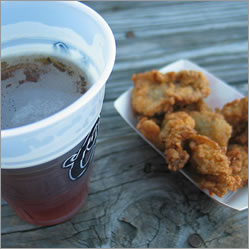Beer and Oysters go great together. Beer is commonly served with seafood of all sorts. The key to enjoying your seafood dinner is finding just the right beer to enjoy with it. From fish and chips to sushi to raw or fried oysters, complimentary flavors can be found. The culinary joys of beer and seafood are celebrated in festivals, such as Richmond, Virginia’s "River City Beer & Seafood Festival"; recipes, such as Oysters boiled in beer, beer-battered fish; and cultural traditions from seaside villages all over the world.
 Many kinds of beer work well with oysters. Porter, Stout, IPA. Strong flavors work well to cleanse the palate in between bites so that the fishiness of the oysters is not overwhelming. A good, clean break in between bites is highly desirable. In regions where beer choice is limited, beer is still preferable to non-alcoholic drinks. For raw sea foods, a hard liquor is helpful for keeping any rouge bacteria in check. Tequila and Sake shots especially, although please don’t mix.
Many kinds of beer work well with oysters. Porter, Stout, IPA. Strong flavors work well to cleanse the palate in between bites so that the fishiness of the oysters is not overwhelming. A good, clean break in between bites is highly desirable. In regions where beer choice is limited, beer is still preferable to non-alcoholic drinks. For raw sea foods, a hard liquor is helpful for keeping any rouge bacteria in check. Tequila and Sake shots especially, although please don’t mix.
If you are talking about grilled fish, grilled salmon, mussels, prawns, your best bet for a complimentary beer is a dark beer. Porter, Schwarzbier, Stout, all go well in this setting. I recommend the black lager especially for enjoying beer and oysters a hot or warm day.
Lighter beers have their place, too. Certainly for broiled or boiled fish, shrimp, mussels, a pale ale, a pilsner, or even wheat beer can be quite complimentary. Bitters and IPAs can also help break down the oily taste of deep fried sea foods (very popular). A good idea to wash down a plate of fish and chips. This would be my choice for raw, shucked oysters, especially when I am enjoying them on the gulf coast of Vera Cruz in Mexico. I always like to stop for raw oysters when traveling in that region.
One place where you can sample all of this and mix and match is Richmond, Virginia’s River City Beer & Seafood Festival in June. Over 40 varieties of beer show up among vendors, brewers, and chefs at this festival annually to celebrate the union of microbrew and seafood. Music is provided by the festival, and samples are provided for a festival fee. For $25, you can buy a festival sample mug to enjoy unlimited samples from the brew selection.
Another festival honoring this tradition is the Confluence Wine, Beer, Seafood & Music festival in Oregon state’s Douglas County on the Oregon Coast. Admission is only $7 at the door or $5 in advance. Confluence means "the flowing together of two rivers or more rivers." The festival is held at just such an intersection, at Gardiner, Oregon, just two miles north of Reedsport. A confluence is also "a coming or flowing together, meeting, or gathering at one point." The perfect name for an event which gathers so many different aspects together under one banner.
Brewers in the land down under have found a way to express their love of beer and seafood. From Australia comes a unique beer designed specifically to enhance the flavors of seafood. According to Blue Bottle Beer’s website:
"…[we’ve joined] American hops with German yeast, Australian barley and fused it with the cleanest water. We then added our unique ‘zesty finish’. Bluebottle Beer ® is a seductive blend of lifted aromatics, bitterness, and a citrus sting to enhance the flavors of the sea."
This would seem to go well with broiled, boiled, or BBQ’ed fish and seafood. The zesty citrus sting they allude to gives me the idea that some Belgian ales would also enhance a seafood meal.
Recently, when I went to eat at San Antonio’s Water St. Oyster Bar, I encountered the particular mix of Chimay with some Arcadian style cooking, and I must say I was quite pleased! The especially spicy styles of cooking coming from the Louisiana area need a powerful beer to balance them best.


